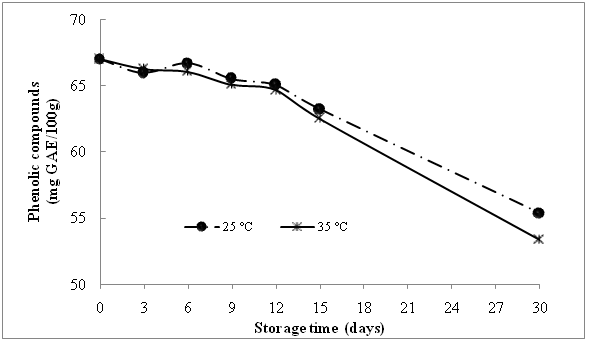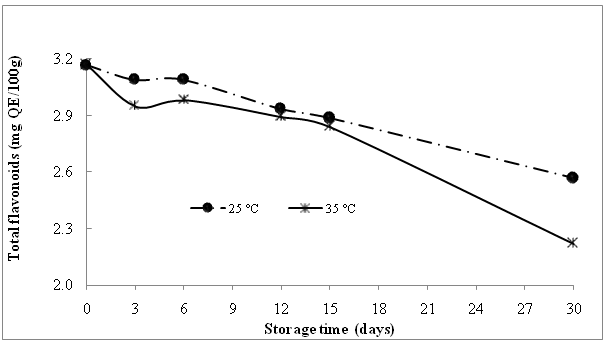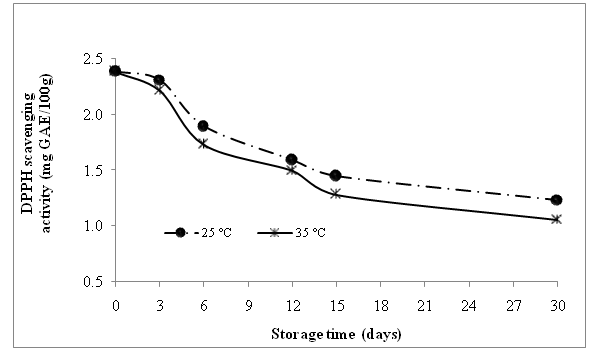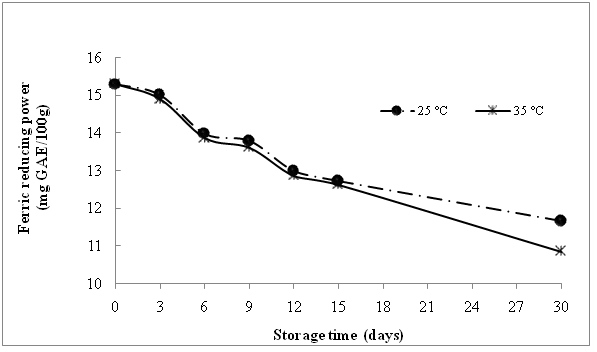Impact of storage conditions on the bioactive compounds and antioxidant capacity of commercial orange jam
Ouarda Djaoudene, Hayette Louaileche*
Affiliation
Hayette, Louaileche. Laboratoire de Biochimie Appliquée, Faculté des Sciences de la Nature et de la Vie, Université de Bejaia, Algérie.
Corresponding Author
Hayette, Louaileche. Laboratoire de Biochimie Appliquée, Faculté des Sciences de la Nature et de la Vie, Université de Bejaia, 06000 Bejaia, Algérie, Tel: +213-34 21 47 62; E-mail: haylouaileche@yahoo.fr
Citation
Djaoudene, O. and Louaileche, H. Impact of Storage Conditions on the Bioactive Compounds and Antioxidant Capacity of Commercial Orange Jam. (2016) J Ana Bioanal Sep Tech 1(1): 8-11.
Copy rights
© 2016 Louaileche, H. This is an Open access article distributed under the terms of Creative Commons Attribution 4.0 International License.
Keywords
Storage conditions; Phenolics; DPPH; Ferric Reducing Power; Orange jam
Abstract
Storage conditions are important factors for fruit jam quality and antioxidant potential. The effects of storage time and temperature on stability of bioactive compounds such as total phenolics and flavonoids and total antioxidant capacity of orange jam were investigated. The jam samples were stored for a period of 30 days at 25 and 35°C. Total phenolic content of samples was determined by the Folin-Ciocalteu method. Antioxidant capacity was determined by spectrophotometric methods and was based on the evaluation of free-radical scavenging activity (FRSA) using DPPH radical and ferric reducing power (FRP). In the current study, the results showed that by the end of storage, the bioactive compound contents and antiradical activity decreased significantly. Also, extremely significant correlation (p < 0.001) was observed between phenolic and flavonoid contents, and antioxidant capacity (FRSA and FRP) of orange jam. Regardless of the phenolic compound loss after storage, orange jams are good sources of substances with antioxidant potential.
Introduction
Several epidemiological studies suggest that diets rich in phytochemicals and antioxidants perform a protective role on health. Phenolics are important secondary plant metabolites and are widely distributed in many fruits and vegetables[1]. Among fruits, citrus fruits are rich sources of bioactive compounds such as flavonoids, phenolic acids and vitamin C, which display potential health-promoting effects. Dietary intake of phenolics has been associated with reduced risk of chronic diseases, such as heart disease and cancer, probably due to their antioxidant properties[2,3]. Many studies have suggested that the major antioxidant activity in fruits is due to the presence of phenolic compounds.
Due to seasonal effects on the fruit availability and their shelf life limit, it is interesting to determine whether fruit-derived products such as jams could also represent good sources of bioactive compounds. Jams are usually produced by cooking fruits with sugar and other additives such as pectin and citric acid[4,5]. Literature data indicate that quality parameters of foods are affected by many factors including storage temperature and duration, packaging material, and oxygen concentration. The effect of storage on degradation of bioactive compounds and total antioxidant capacity was investigated in strawberry[6], blackberry[7], strawberry, cherry, apricot, fig and orange jams[8]. However, to the best of our knowledge there are few papers worldwide and none in Algeria concerning the effects of storage temperature on the phytochemical contents and antioxidant capacity of orange jam. Hence, the objective of the current study was to evaluate the changes in the phytochemical (total phenolics and flavonoids) contents and antioxidant capacity of commercial orange jam marketed in Algeria, during storage at two different temperatures.
Materials and Methods
Chemicals
Folin–Ciocalteu reagent, and methanol were from Biochem, Chemopharma (Montreal, Quebec); sodium carbonate was from Sigma–Aldrich (Switzerland); aluminium chloride and potassium ferricyanide were from Biochem, Chemopharma (Georgia, USA); gallic acid was from Prolabo (Montreuil, France) and 1,1-diphenyl-2- picrylhydrazyl (DPPH) was from Sigma–Aldrich (Germany).
Samples and preparation of extracts
Three units each from two batches of orange jam marketed in Algeria were used in the current investigation. Based on the details indicated on the label, jam is composed of fruits, sugar (sucrose), pectin, citric acid and preservative (E202). The samples were divided into two groups. The first group was stored at 25°C and the second at 35°C. The tested parameters were determined before storage of samples, and after 3, 6, 9, 12, 15 and 30 days
Extracts were prepared by mixing one gram of sample with 20 ml of 50% acetone. After agitation and centrifugation at 5000 rpm for 15 min, the extracts were recovered after filtration.
Determination of Total Phenolic Contents (TPC)
The phenolic content of extracts was determined with: the Folin-Ciocalteu reagent using the method of Singleton and Rossi[9]. Briefly, acetone extract (200 μL) was mixed with 1/10 (v/v) diluted Folin-Ciocalteu reagent (700 μL) and 7.5% sodium carbonate (400 μL). The mixture was incubated at room temperature for 90 min, and the absorbance was measured at 765 nm (Uviline 9400 UV-visible spectrophotometer, Secomam, France). TPC were expressed as mg gallic acid equivalents per 100 g of jam (mg GAE/100 g).
Determination of Total Flavonoid Contents (TFC)
The flavonoid content of the extracts was determined according to the procedure described by Quettier-Deleu et al[10]. One thousand microlitres of sample were mixed with 1 mL of aluminium chloride. The mixture was allowed to stand at room temperature for 10 min. Absorbance was measured against the blank at 410 nm. TFC were expressed as mg quercetin equivalents per 100 g of jam (mg QE/100 g).
Antioxidant activities
1. Free Radical Scavenging Activity (FRSA): The 2, 2 diphenyl-1-picrylhydrazyl (DPPH) radical was used to measure the antioxidant activity of jam[11]. Each extract (500 μL) was added to 1 mL of methanolic DPPH solution. The decolorizing process was measured at 517 nm after 30 min of reaction and compared to a blank control. The antioxidant activity was expressed as mg gallic acid equivalents per 100 g of jam (mg GAE/100 g).
2.5.2. Ferric Reducing Power (FRP): The ferric reducing power of the extracts was measured according to Oyaizu[12] One hundred microlitres of extract were mixed with 250 μL of phosphate buffer (0.2 M, pH 6.6) and 250 μL of 1% potassium ferricyanide. After incubation for 20 min at 50°C, 250 μL of 10% trichloroacetic acid and 850 μL of distilled water were added to the mixture, and finally 170 μL of 0.1% ferric chloride were added. The absorbance was measured at 700 nm. Gallic acid was used as a standard and ferric reducing power was expressed as mg GAE/100 g of jam.
Statistical analysis
Data were analyzed using infostat software. Analysis of variance was performed by ANOVA procedure with two factors; the model included the effects of storage time and temperature. Means were separated by LSD analysis at a least significant difference of P < 0.05 value. Experiments were conducted in triplicates. Correlations were performed using the correlation matrix of STATISTICA 5.5 software at three different significant levels (0.05, 0.01 and 0.001).
Results and Discussion
Phenolic compound content
Phenolic compounds are the most abundant antioxidants in the human diet, and are widespread constituents of fruits and vegetables. These compounds are of considerable interest due to their antioxidant properties. The changes in total phenolic content during storage of orange jam are presented in Figure 1. The initial total phenolic content of analyzed samples is 70 mg GAE/100 g. Rababah et al[8]. reported a total phenolic content of 44 mg GAE/100 g of orange jam. This difference may be due to fruits variety used, the degree of maturity and elaboration process.
The statistical analysis revealed that storage time and temperature have an influence on total phenolic content as determined by Folin-Ciocalteu assay. Content of these compounds decreased significantly (p < 0.05) during storage under the experimental conditions applied. Significant losses in total phenolics (17 - 20%) were observed as a result of storage, after 30 days at 25°C and 35°C. These results were consistent with the findings of De Moura et al[7] and Poiana et al[13] who reported a decrease in phenolic content in strawberry and blackberry jams after 3 months at 20°C and 6 months at 10 and 20°C, respectively. Also, Rababah et al[8] concluded a decrease in total phenolic compounds of orange jam stored at 25°C for 5 months. The reduction in phenolic content could mainly be resulted from oxidation and polymerization reactions.
Figure 1: Effect of storage on phenolic compound content of orange jam.
Flavonoid content
Flavonoids are among the most studied phytochemicals in plant foods and include a large number of different molecules which may result in diverse biological activities[14]. However, the literature available is poor in references about evolution of orange jam flavonoid content during storage. A significant (p < 0.05) loss in total flavonoid content of the analyzed jam (Figure 2) was observed after 30 days of storage; the content of these bioactive compounds decreased by 19 and 30% at 25 and 35°C, respectively. Similar results were reported by Zafrilla et al[15]
for flavonol contents of strawberry jams stored 6 months at 20°C. In addition, Igual et al[3] found a loss from 29 to 39% for flavonoids in grapefruit jam during storage (90 days at room temperature).
Figure 2: Effect of storage on total flavonoid content of orange jam.
Antioxidant activity
In order to assess the antioxidant capacity of orange jam during storage, two methods based on different reaction mechanisms were determined. The first is radical scavenging activity which is based on the extract ability to neutralize DPPH radical; the second is ferric reducing power (FRP) which is based on the ability of extract to reduce Fe3+.
1. Free radical scavenging activity: Fruits generally possess a good antioxidant activity, which is linked to their high contents of phenolic compounds. Numerous studies have suggested that the phytochemical content and corresponding antioxidant activity of fruits and their processed products contribute to their protective effect against chronic and degenerative diseases. Because the evaluation of the antioxidant capacity of foods commonly consumed in the diet is of great importance, antioxidant capacity of orange jam during storage was evaluated by DPPH radical scavenging activity method (Figure 3). The results showed that initial free-radical scavenging activity of orange jam was reduced by 48.5 and 56% after 30 days storage at 25 and 35°C, respectively. Statistically, interaction time-temperature factor had significant effects on antioxidant potential. According to Amakura et al[1], radical scavenging activity of bayberry, blackcurrant, blackberry, blueberry, raspberry, red currant and strawberry jam decreased by 50 - 60%. The results of our study agreed with those of Wicklund et al[16] who reported a reduction in antioxidant activity of strawberry jam. A loss of 50% was reported by Rababah et al[8] in orange jam stored for 5 months at 25°C.
2. Ferric reducing power: The presence of reductants causes the reduction of Fe3+ ferricyanide complex to the ferrous form; Fe2+ is monitored by measuring the formation of Perl’s Prussian blue at 700 nm. The ferric reducing power may serve as a significant indicator of the antioxidant potential. Prior to storage, the analyzed jam exhibited a ferric reducing potential of 15.3 mg GAE/100 g. As shown in figure 4, storage caused a decrease of 22 and 29% of reducing power of orange jam stored for 30 days at 25 and 35°C, respectively. This decrease could be attributed to the destruction of phenolics compounds. These results were consistent with data reported for bilberry jam[13] and strawberry jam[16]. Also, Poiana et al[13] indicated that reducing power of strawberry, sweet cherry and sour cherry jams decreased by 19, 15 and 11%, respectively, after a storage of 3 months at 20°C.
Figure 3: Effect of storage on free radical scavenging activity of orange jam.
Figure 4: Effect of storage on ferric reducing power of orange jam.
Correlations
Correlation analysis was used to explore the relationship between different measured variables. The correlation matrix presented in Table 1 revealed correlation between bioactive compound content and antioxidant activity. A highly positive correlation was observed between total phenolic and flavonoid contents (R2 = 0.94). The antioxidant capacity of samples was influenced by the content of bioactive compounds; FRSA and FRP activities were extremely and significantly correlated (p < 0.001) with TPC (R2 = 0.81 and R2 = 0.95, respectively) and TFC contents (R2 = 0.84 and R2 = 0.91, respectively). This indicates that these compounds are a major responsible for free radical scavenging ability and ferric reducing power of the investigated jam. Similar results were reported by Patras et al[6] for antioxidant activity and total phenolic content of strawberry jam. A highly positive correlation (R2 = 0.74) was found by Rababah et al[8] between total phenolics and ntiradical activity of orange jam. Poiana et al[13] and Danijela et al[17] have also reported that DPPH radical scavenging capacity and ferric reducing power were positively correlated with total phenolic and flavonoid contents of bilberry and strawberry jams. A highly positive significant correlation was also observed between both antioxidant assays FRSA and FRP (R2 = 0.90); this may be due to the presence of molecules displaying simultaneously antiradical and reducing properties.
Table 1: Correlation matrix between phytochemical content and antioxidant activity of orange jam.
| Parameter | Total phenolic | Total flavonoids | FRSA | FRP |
| Total phenolics | 1.00 | |||
| Total flavonoids | 0.94*** | 1.00 | ||
| FRSA | 0.81*** | 0.84*** | 1.00 | |
| FRP | 0.95*** | 0.91*** | 0.90*** | 1.00 |
FRSA: free radical scavenging activity; FRP: ferric reducing power
***p < 0.001: extremely significant correlation.
Conclusion
The results of the present study confirmed that storage resulted in a decrease of bioactive compounds such as phenolic compounds and flavonoids, and antioxidant activity of commercial orange jams. Since there is a great interest in these compounds because of increasing evidences of beneficial effects to human health, it is important to know to what extent they are affected by storage time and temperature. Phenolic compounds and antioxidant activity of orange jams were relatively low at high storage temperatures. Thus, the effects of storage on the phytochemicals and antioxidant capacity of fruit jams should be considered prior to selection of storage conditions.
Acknowledgement:
The authors are grateful to the Algerian Ministry of Higher Education and Scientific Research for the financial support.
References
- 1. Amakura, Y., Umino, Y., Tsuji, S. et al. Influence of jam processing on the radical scavenging activity and phenolic content in berries. (2000) J Agric Food Chem 48(12): 6292-6297.
- 2. Šavikin, K., Zdunić, G., Janković, T., et al. Phenolic content and radical scavenging capacity of berries and related jams from certificated area in Serbia. (2009) Plant Foods for Hum Nutr 64(3): 212-217.
- 3. Igual, M. Garcia-Martinez, E., Camacho, M.M. et al. Jam processing and storage effect on β-carotene and flavonoids content in grapefruit. (2013) J Functional Foods 5(2): 736-744.
- 4. Da Silva Pinto, M., Lajolo, F.M., Genovese, M.I. Bioactive compounds and antioxidant capacity of strawberry jams. (2007) Plant Foods for Hum Nutr 62(3): 127-131.
- 5. Pavlova V., Karakashova L., Stamatovska V., et al. Storage impact on the quality of raspberry and peach jams. (2013) J Hygienic Engg Design 664: 25-28.
- 6. Patras A., Brunton N. P., Tiwari B. K. et al. Stability and degradation kinetics of bioactive compounds and colour in strawberry jam during storage. (2011) Food Bioprocess Technol 4(7): 1245-1252.
- 7. De Moura, S.C.S.R., Da Rocha Tavares, P.E., Germer, S.P.M., et al. Degradation kinetics of anthocyanin of traditional and low-sugar blackberry jam. (2012) Food Bioprocess Technol 5(6): 2488- 2496.
- 8. Rababah ,T.M., Al-Mahasneh, M.A., Kilani, I., et al. Effect of jam processing and storage on total phenolics, antioxidant activity, and anthocyanins of different fruits. (2011) J Sci Food Agric 91(6): 1096-1102.
- 9. Singleton, V.L., Rossi, J.A. Colorimetry of total phenolics with phosphomolybdic-phosphotungstic acid reagents. (1965) Am J Enol Viticulture 16: 144-158.
- 10. Quettier-Deleu, C., Gressier, B., Vasseur, J., et al. Phenolic compounds and antioxidant activities of buckweat (Fagopyrum esculentum Moench) hulls and flour. (2000) J Thnopharmacol 72(1-2): 35-42.
- 11. Tezcan, F., Gultekin-Ozguven, M., Diken, T., et al. Antioxidant activity and total phenolic, organic acid and sugar content in commercial pomegranate juices. (2009) Food Chem 115(3): 873-877.
- 12. Oyaizu, M. Studies on products of browning reactions Antioxidative activities of products of browning reaction prepared from glucosamine. (1986) Jap J Nutr 44: 307-325.
- 13. Poiana, M.A., Alexa, E., Mateescu, C. Tracking antioxidant properties and color changes in low-sugar bilberry jam as effect of processing, storage and pectin concentration. (2012) Chem Cent J 6: 2-11.
- 14. Hidlago, M., Sanchez, S.M., Pascual, T. Flavonoid-flavonoid interaction and its effect on their antioxidant activity. (2010) Food Chem 121(3): 691-696.
- 15. Zafrilla P., Ferreres F., Tomas-Barberan, F.A. Effect of processing and storage on the antioxidant ellagic acid derivatives and flavonoids of red raspberry (Rubus idaeus) jams. (2001) J Agric Food Chem 49(8): 3651-3655.
- 16. Wicklund, T., Rosenfeld, H.J., Martinsen, B.K., et al. Antioxidant capacity and colour of strawberry jam as influenced by cultivar and storage conditions. (2005) Food Sci Technol 38(4): 387-391.
- 17. Danijela, B., Branka, L., Verica, D. Free radical scavenging activity and phenolic content in strawberry fruit and jam. (2009) Agric Conspec Sci 74(3): 155-159.
















